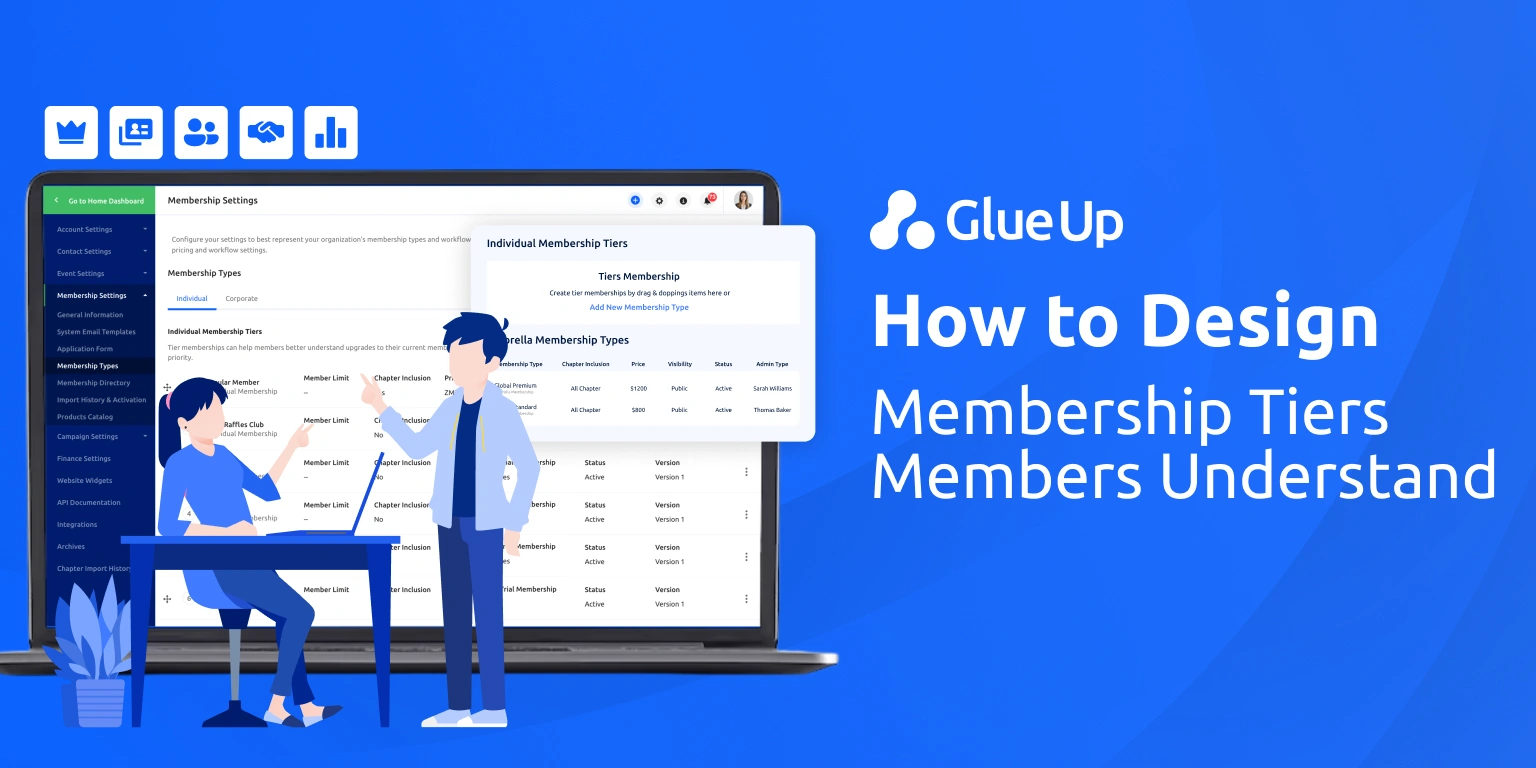
Membership agreements are the unglamorous backbone of every association, chamber of commerce, and member-based organization. They decide whether those members trust you enough to stay year after year. Yet ask the average member if they’ve ever actually read the agreement they signed, and most will shrug. That gap; between compliance and comprehension; is exactly why learning how to create a membership agreement (w template) is not a box-checking exercise, but a direct play for long-term retention and organizational credibility.
This isn’t about drafting contracts that only lawyers can love. It’s about designing agreements that respect the law, protect your organization, and, most importantly, earn the attention and trust of your members.
Key Takeaways
Membership agreements should use plain language at about an eighth-grade reading level, with short sentences, clear headings, and good spacing. This makes them easier for members to actually read and trust.
Auto-renewals, dues increases, and cancellations need to be spelled out clearly. Members should always know renewal dates, receive reminders in advance, and be able to cancel through the same channel they used to sign up.
Service emails such as receipts and renewal notices are required, but marketing emails and texts should always require separate, explicit opt-in consent. Bundling them into the membership agreement risks legal trouble and undermines trust.
For organizations with international members, agreements should cover compliance in different regions, including Canada’s PAD Rule H1 for bank debits, GDPR and PECR in the EU and UK, and TCPA in the U.S. for SMS marketing.
Finally, membership agreements should be designed like products. Using visuals such as tables for dues, timelines for renewals, and flow diagrams for cancellations helps members understand terms faster and reduces disputes.
Quick Reads
Why “How to Create a Membership Agreement (w Template)” Is the Most Overlooked Growth Lever
When leaders talk about growth, they usually bring up recruitment campaigns, event sponsorships, or new digital platforms. Rarely does anyone say, “Let’s rethink our membership agreement.” And yet, research on contract readability and design shows that the way you present terms directly impacts whether people follow through, pay on time, or renew.
The Nielsen Norman Group, a global authority on user experience, has demonstrated for decades that plain language is not “dumbing down” content, it’s smart business. Even experts prefer agreements written at an eighth-grade reading level. Add to that a generational shift: Millennials and Gen Z members are less tolerant of legalese and more likely to abandon organizations that feel opaque or manipulative.
For associations, the stakes are higher than ever. With budgets tight and members weighing ROI on every dollar, a confusing agreement can be the difference between a five-year loyalist and a one-year churn statistic. That makes the humble agreement a growth lever hiding in plain sight.
How to Create a Membership Agreement (w Template) That People Actually Read
Start with clarity, not clauses. The average adult reads at a middle school level, and even executives prefer brevity when scanning a contract. That doesn’t mean stripping away legal protections, but it does mean using short sentences, active voice, clear headings, and generous white space.
Think of your agreement as a landing page. Members should be able to skim and know the essentials: what they get, what they owe, how long it lasts, and how to get out. Detailed terms can follow, but the overview should feel like a quick-reference guide, not a legal labyrinth.
Typography matters too. Studies on legibility show that older readers in particular struggle with dense fonts and small print. Associations with multi-generational memberships should choose readable fonts, use at least 12-point size, and avoid walls of text. A poorly designed page is a cognitive tax on your members.
Glue Up clients who embed their agreements into digital onboarding workflows often add a one-page “quick view” summary before the full text. This ensures new members see the most important terms up front, then have the option to read the full details.
How to Create a Membership Agreement (w Template) That Is Enforceable and Compliant
A readable agreement is only valuable if it also holds up legally. That means getting serious about electronic signatures and recordkeeping.
In the United States, the ESIGN Act and the Uniform Electronic Transactions Act (UETA) confirm that e-signatures are as enforceable as wet ink signatures, provided four conditions are met: intent to sign, consent to transact electronically, association of the signature with the record, and secure retention of that record.
For associations, this means your agreement should always include an Electronic Records and Signature Consent clause, plus a process for storing agreements securely. If a member disputes an auto-renewal or fee, you need more than “we think they agreed”, you need auditable proof. Platforms like Glue Up simplify this by capturing e-signatures natively and storing agreements alongside member profiles.
How to Create a Membership Agreement (w Template) That Handles Renewals and Cancellations Transparently
Auto-renewal and cancellation terms are the flashpoints of member trust. Across the United States, state-level auto-renewal laws (ARLs) increasingly require clear disclosure of renewal terms, advance notice before renewal, and easy cancellation. California’s law is the strictest, but more than half of states have enacted similar rules.
At the federal level, the Federal Trade Commission (FTC) has attempted to introduce a “Click to Cancel” rule requiring businesses to make cancellations as easy as sign-ups. While implementation has been delayed and challenged in court, the momentum is clear: regulators want transparency, and members expect it.
For your agreement, this translates into plain, unavoidable language:
Term length: “Your membership runs from January 1, 2025, to December 31, 2025.”
Renewal date: “On January 1, 2026, your membership will automatically renew unless you cancel.”
Reminder: “We will email you 30 days before renewal with instructions on how to cancel.”
Cancellation method: “Cancel online, by phone, or by replying to this email. No forms, no hidden steps.”
These are signals of respect. A member who feels trapped is a member already halfway out the door. Glue Up allows associations to automate renewal reminders, log cancellations, and track member feedback, closing the loop between agreement and experience.
How to Create a Membership Agreement (w Template) That Works Across Borders
Membership organizations rarely operate in a single jurisdiction anymore. Chapters, affiliates, and cross-border programs make agreements trickier.
In Canada, recurring payments by direct debit require compliance with Payments Canada’s Rule H1, which governs Pre-Authorized Debit (PAD) agreements. Your agreement must clearly outline the authorization, amount, notice period for changes, and cancellation process. Without this, a member can reverse payments and your organization is exposed.
In the European Union and United Kingdom, marketing consent is tightly regulated under GDPR and PECR. You cannot bundle consent for marketing emails or texts inside a membership agreement as a condition of joining. Consent must be separate, specific, and revocable.
In the United States, the Telephone Consumer Protection Act (TCPA) requires express written consent for marketing texts, and that consent must be specific to your organization. A single checkbox for “I agree to terms” will not protect you.
If your membership is global, the safest approach is to separate service communications (renewal notices, receipts) from marketing communications (newsletters, promotions) and handle consent differently. Glue Up’s CRM functionality helps organizations manage these nuances at scale by recording separate consents and automating compliance across markets.
How to Create a Membership Agreement (w Template) That Respects Privacy and Trust
Privacy is an emotional contract with your members. Members want to know what data you collect, how you use it, and how they can control it.
If your organization accepts members under 18, you also need to address age restrictions and parental consent. In the United States, the Children’s Online Privacy Protection Act (COPPA) prohibits collecting data from children under 13 without verified parental permission. Even if your audience is primarily adults, it is smart to include an age eligibility clause to protect your association.
Another overlooked area is media release. If you plan to use photos or videos from events, your membership agreement should include a short, plain-language release clause with an opt-out mechanism. This avoids disputes later when a member’s image appears in promotional materials.
Designing the Membership Agreement Like a Product
Contracts don’t have to be walls of text. A growing field known as legal design shows that adding visuals: timelines, icons, diagrams; dramatically improves comprehension and reduces disputes.
Imagine a renewal section with a simple timeline graphic: sign-up → reminder → renewal → cancellation option. Or a dues section that uses a table: annual membership, quarterly payment, one-time setup fee. Members absorb this instantly without needing to parse paragraphs.
Research by Stefania Passera and Stanford’s Legal Design Lab shows that these design elements are legally safer because misunderstandings are reduced.
For member-based organizations, this design-first approach also signals cultural alignment: you’re an association that values clarity and accessibility, not bureaucracy.
Membership Agreement Template (Editable)
Below is a condensed template you can adapt. A downloadable version should be linked for readers.
Membership Agreement
1. Membership Benefits
By joining [Organization Name], you gain access to [list key benefits, e.g., events, resources, discounts].
2. Membership Term and Renewal
Your membership runs from [start date] to [end date]. Unless canceled, it renews automatically. You will receive a reminder 30 days before renewal.
3. Cancellation
You may cancel anytime by [methods]. Cancellation takes effect at the end of your paid term.
4. Dues and Payments
You authorize us to charge [amount] on [schedule]. Failed payments may result in suspension.
5. Electronic Records and Signature
You consent to receive and sign records electronically.
6. Communications
Service communications are required. Marketing emails or texts require your separate consent.
7. Privacy and Age Eligibility
You must be at least [age]. We handle your data in line with our Privacy Policy.
8. Code of Conduct and Media Release
Members agree to uphold respectful conduct. Event photos/videos may be used unless you opt out in writing.
9. Governing Law
This agreement is governed by the laws of [jurisdiction].
Signature: _______________________
This short format keeps things human, while annexes or appendices can add country-specific requirements (like Canada PAD).
How to Roll This Out with Glue Up
Run a readability test (target grade 8).
Add visuals: renewal timeline, dues table.
Include e-signature and e-records consent.
Automate renewal reminders through Glue Up.
Separate marketing consent forms.
Store agreements centrally in Glue Up’s CRM.
Monitor cancellation feedback for patterns.
Why Glue Up Is the Only Platform That Completes the Agreement Cycle
A membership agreement is not a relic; it’s the DNA of your member relationship. But an agreement without systems to enforce, remind, and respect it is just paper. Glue Up closes that gap.
With Glue Up, you can:
Embed agreements in your digital sign-up process.
Capture legally valid e-signatures.
Automate reminders for renewals.
Track payments, cancellations, and disputes.
Store agreements in one central CRM.
The result: compliance, transparency, and trust at scale.
Download the template today, then book a demo with Glue Up to see how your agreements live and breathe inside a platform built for member-based organizations.



